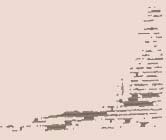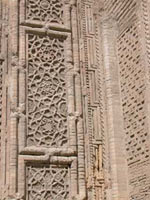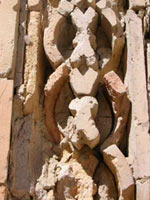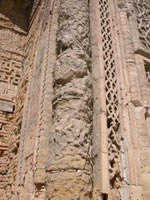


|
Magoki Attoron Mosque
Before the Arab conquest there was a bazaar close by the site of the
Magak-i Attari Mosque (Magoki Attoron Mosque), i.e. the "Mosque in pit". It was a
market for idols, potions and spices - attar (perfumes). Besides this, there, was formerly a
Temple of the moon (Mokh) at this place.
During this time Bukhara functioned as a cult center for the worship of Sin the god of the moon. The two chief seats of Sin's worship were Ur in the south and Harran to the north of Mesopotamia. The cult of Sin spread to other centers, and
temples of the moon-god are found in all the large cities of Babylonia and Assyria. The
moon-god is by excellence the god of nomadic peoples, since the moon is their guide and protector at night when they undertake their wanderings. Therefore, the cult most likely arose at the place of Bukhara from the very outset of the first settlements because of
inter-nomadic connections.
Approximately once a lunar cycle, the inhabitants of the Zaravshan Valley exchanged their old idols of Sin for new ones. The trade festival took place in front of the
Moon (Mokh) Temple. This festival was important in assuring the fertility of land on which all
inhabitants of the delta of Zaravshan depended. Because of the trade festivals, Bukhara became a center of commerce.
Abu Bakr Muhammad ibn al-Narshakhi of Bukhara, who had completed his book in 943 A.D. (A.H. 332), mentions the mosque, which was built on the site of former
Mokh Temple. He used the name "magok", i.e. "in a pit", because even then half of it was concealed from view by the rising soil level. Hence, the mosque, perhaps, is
one of the earliest religious buildings of Islamic era in Bukhara. Choice of place for the mosque also proves this assumption, because Arab conquerors built their sanctuaries first of all at the places of prostrated cults. In Bukhara, it had taken place at least once more; the very first cathedral mosque was built at the place of destroyed
temple of fire-worshippers. There is opinion that the Kalyan Mosque was afterwards built exactly at that place.
Before the construction of the first
synagogue in the 17-th century
Jews had shared a place in the Magak-i Attari Mosque with Muslims. Some say that Jews and Muslims worshipped alongside each other in the same place at the same time. Other sources insist that Jews worshipped after Muslims. This perhaps explains the Bukharan Jewish custom of saying
"Shalom Aleyhim" ("Peace be with you") after morning prayer. This custom is lacking amongst European Jews.
Abdul-Aziz-khan I (gov. 1533-1550) had made thorough repairs of the mosque in 1549.
New eastern upper portal was built, because the ancient southern portal remained under the ground. Now released the southern portal represents genuine
masterpiece of early Islamic architecture in Bukhara.
The Lyabi Khauz Ensemble & Synagogue of Bukhara
The Labi Khauz, i.e. "at the pond",
is the title given to the area surrounding one of the few remaining
Hauz or ponds surviving in the city of Bukhara. Until the Soviet
period there were many such ponds, which were the city's principal
source of water, but they were notorious for spreading disease and
were mostly filled in during the 1920s and 30s. The Lyab-i Hauz
survived because it is the centrepiece of a magnificent
architectural ensemble, created during the 16th and 17th centuries,
which has not been significantly changed since.
The ensemble comprises three monumental structures:
Kukeldash Madrasah in the north,
Khanaka (1619-20) in the west and
Nadir divan-begi Madrasah (1622/23) (Nodir Devan-Begi Madrasah) in the east.
The small Qazi-e
Kalyan Nasreddin madrasah (now demolished) was formerly located
beside the Kukeldash Madrasah. The Kukeldash Madrasah (1568/69)
The word "kukeldash" literally means "foster-brother". In a hierarchy of power inherited from Genghis-khan this word designates one of the most important positions of khans' court. The sponsor of Kukeldash Madrasah was
highly influential emir Kulbaba, who held a post of Kukeldash under several khans of
the Shaibanid dynasty. It is historically proven, that emir Kulbaba Kukeldash gave help to
Abdulla-khan II (1561-1598) - the most powerful khan of the Shaibanid dynasty - to come to power. According to the hallowed tradition of
consecration of the khan inherited from Mongols - in the states that appeared after disintegration of the empire - each new khan ought to be lifted lying on the sheet of white felt. The power to strain the sheet from four corners had four men recognized as most influential figure in a commonwealth. Emir Kulbaba was one of four men who consecrated Abdulla-khan II. The title "khan" could be given only to
"tore" - agnate lineal descendant of Genghis-khan.
The greatest in size (80 x 60 meters and over 130 hujras) among other madrasahs in Bukhara, Kukeldash Madrasah became a symbol of the steadfast state under Abdulla-khan. The madrasah also famed as splendid example of "white interior". The entrance gate is of particular interest, inlay fixtures are devoid of glue or nails. The main front is adorned with geometrical ornaments.
Impact of Nadir Divan-begi
Historical background
Divan-begi is a title that designated the post right after khan in the Bukhara khanate.
Nadir Divan-begi held this position during the reign of Imam Quli-khan (1611-1642), the strongest khan of
the Ashtarkhanid (Janid) dynasty (established in 1599). The rulers of Janid dynasty was alien to powerful Shaibanid feudal lords, therefore Imam Quli-khan hardly retained his power by force. The devotion to Islam tradition in the state under Janid dynasty was pale before the eagerness of the time of prominent Shaibanid khans. These two important peculiarities of the power were soon expressed in remarkable architecture tendency. In 1619
Yalantush-biy who virtually independently governed
Samarkand had begun the construction of grand madrasah (Sher-Dor Madrasah). The rich colored finishing and the
depiction of sun, tigers and antelopes tell of a pioneering approach to artistic expression,
unique in the Islamic world.
The Nadir Divan-Begi Madrasah (1622/23)
In three years Nadir Divan-begi followed Yalantush-biy by construction of his own revolutionary structure (Nadir Divan-Begi Madrasah). Originally Nadir Divan-begi intended the building to be a
caravanserai (not that it was allowed to portray human or animal figures on them either but it was marginally better than on a madrasah). But at the inauguration ceremony, Imam Quli-khan unexpectedly proclaimed the supposed caravanserai is to be a madrasah. So Nadir Divan-begi was obliged to rearrange the caravanserai, by adding on to the front the loggias and angular towers. He also constructed an additional storey with
cells (hujras). At the same time the madrasah does not have a lecture room!
The entrance portal has depictions of 2 phoenix birds, 2 misshapen white deer and a "man-in-the-sun" face.
The Khanaka of Nadir Divan-begi (1619/20)
This Khanaka a rectangular edifice topped with a dome. The building has non-traditional narrow and prolate main portal
along with two lateral entrances. The hall (dhikr-hana) has excellent acoustic properties. The inner walls of the hall are recessed with niches fringed with stucco moldings. The dwelling space occupies corners and lateral exterior walls of the building. The finishing of the main entrance gate is made quite conservatively, with an exception of some floral elements in
ornamentation. The edges of the main portal are overworked with epigraphy ornaments. The main front of the khanaka is cornered with towers cut at a level of the walls.
The khanaka, owing to its location and size (side of the square hall is 11,2 m. - 36,75 ft.) in the course of centuries was the
prominent cultural and religious centre of Bukhara.
The story
According to local story, when Nadir Divan-begi built the Khanaka, near the site of the building there, was a large holding, owned by an
old Jewish widow. Nadir Divan-begi had decided that this site would be the perfect place for pond. However, the widow turned down his offer to buy the property. Then Nadir Divan-begi brought her before Imam Quli-khan in the hope that he would coerce her into selling. Imam Quli-khan ordered a congress of muftis to inquire into the question. However, these specialists in Muslim law decided that there was no legal way to purchase the property, other than with the widow's consent, since Jews had rights on a par with Muslims if they paid the
Jizyah or poll tax on non-Muslims.
Therefore, Nadir Divan-begi had to build a small reservoir near the house of that stubborn Jewess. Nevertheless, he dug an
aryk - an irrigation ditch - to his new pond in such a way that the water ran right near the Jewish widow's house, although it was more expensive. Soon the water began to undermine the foundations of the widow's house. When she came to Nadir Divan-begi for justice, he confirmed his readiness to buy her house for fair price. The widow rejected the money, laying down her own conditions instead. She promised give up her property if the Bukhara rulers would give to her another piece of land with permission to build a synagogue. In return for the widow’s holding Nadir Divan-begi gave her a plot of land, belonging to him, in residential area, which later was named the
"Jewish quarter" (Mahalli Kuma).
Soon the first synagogue at Bukhara and a large pond, the last
element of the complex, were built. People started to call it the "Lyab-i Hauz", which means "at the pond". The date of its construction is about 1620. However, folk memory retains another epithet -
"Haus-i Bazur" i.e. "made with a force".
The pond
Today Lyab-i Hauz is a right-angled pond (46 x 36 meters), which
stretches from the east to the west. Its edges have the form of the
descending staircase made of massive blocks of yellowish limestone.
Источник
1.
Дмитрий Пэйдж. Бухара. Путеводитель по архитектурным и историческим достопримечательностям
2.
Dmitriy Page. The Guide to Bukhara. History and sights.
3. Роберт Альмеев. История древней Бухары. Под редакцией Академика Академии наук Республики
Узбекистан Ртвеладзе Э.В. См. также
1.
Магак-и
аттари
2.
Magoki-Attari Moschee
3. Карта Бухары
|











